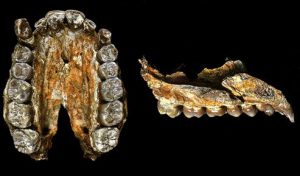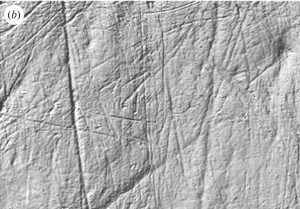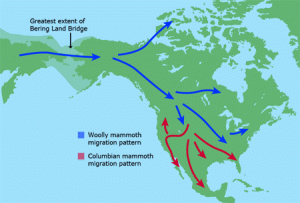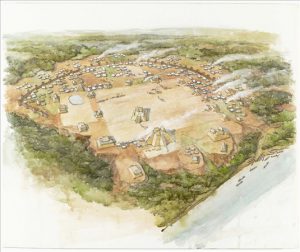Today’s post comes from Bella Dalton-Fenkl, class of 2020 and Art Center Student Docent.
I remember one day last term when I arrived at the Art Center and was met with a surprise—I had to give a tour to fifty people
Category Archives: Site Feed
Diet of Australopithecus Afarensis
Australopithecus afarensis, more commonly known as “Lucy’s species” after Lucy, the famous fossil discovered in Ethiopia in 1974, is an early human species that lived between 3.85 and 2.95 million years ago in Eastern Africa.
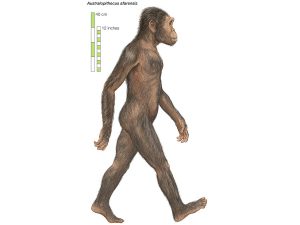
An artist’s rendition of Au. afraensis. Males had an average height of 4 ft 11 and an average weight of 92 lbs, while females had an average height of 3 ft 5 and an average weight of 64 lbs.
A crucial part of understanding Au. afarensis is understanding the specie’s diet and therefore environment, as the environment determines what food is available. To determine the eating habits of Au. afarensis, researchers turned to morphological features relating to diet, such as skull and mandible (jaw) structure and teeth. Based on their strong and robust skulls, large mandibles, and thick enamel, some concluded that Au. afarensis ate hard and brittle foods. However, later studies found that while Au. afarensis could eat these foods, their diet actually consisted of softer foods, mainly grass, leaves, and fruits.
One group of researchers conducted a microwear texture analysis on the teeth of various Au. afarensis specimens. Different types of food interact differently with the teeth, leaving distinct textures and abrasions on the surface. Hard and abrasive foods like nuts and seeds create complex patterns, tough foods such as leaves leave long, narrow scratches, and fruits leave pits. From the patterns left on the teeth, researchers were able to determine what types of food the individuals ate. The results showed that Au. afarensis preferred softer foods such as leaves, grass, and fruit to that of hard and abrasive foods.
Another study came to similar conclusions using stable isotope analysis, a technique that involves analyzing the ratio of carbon in tooth enamel from two categories of plants: one of herbs, trees, and shrubs, and another of tropical grasses, sedges, and succulents. The results suggest that Au. afarensis ate more tropical grasses, sedges, and succulents, a consumption pattern that differs from that of earlier species who tended to avoid these foods.
Although researchers now have a fairly clear idea about the diet of Au. afarensis, the questions still remain as to why they ate softer foods when their morphology suggests that they were able to consume tough foods, and why they expanded their diets to include more grasses and sedges. One theory proposes that Au. afarensis used hard foods as a “fallback” in seasons when softer foods weren’t available. Others suggest that their expanding diets were a result of fluctuations in the environment, and that their ability to eat hard and soft foods allowed them to survive short and long-term climate fluctuations and corresponding changes in available resources. However, other researchers disagrees, claiming that the change in diet was instead due to the species exploiting a larger range of resources in a broader mosaic of habitats including grasslands, woodlands, and wetlands.
More studies are needed to determine which theory is most accurate. The case of Au. afarens’ diet is a prime example of how multiple methods of analysis are necessary to gain an understanding of the past. Additionally, it shows the changing nature of our historical understanding and how new methods and techniques can provide further insight and better knowledge than previously attainable.
Further Reading:
- http://www.sciencedirect.com/science/article/pii/S0047248404000508
- http://johnhawks.net/weblog/reviews/early_hominids/diet/ungar_2005_occlusal_relief_diet.html
Sources:
- http://humanorigins.si.edu/evidence/human-fossils/species/australopithecus-afarensis
- https://phys.org/news/2009-10-ancient-lucy-species-ate-diet.html
- http://www.pnas.org/content/110/26/10495.full
- http://www.pnas.org/content/97/25/13506.full
Images:
Mammoths and Archaeology
History of Mammoth Breeds
Throughout the course of time, there have been a few different types of mammoths. About 1.8 million years ago, a breed of mammoth known today as the southern mammoth crossed into North America via a temporary land bridge in the Bering Strait. The Columbian mammoth was also a prevalent breed in North America, with its range covering the present-day United States down to Nicaragua. The smallest of the mammoth species was the woolly mammoth. A little over 100,000 years ago was the first time they were able to get to North America, again via the Bering Strait land bridge. Archaeologists know the migration patterns based on the ages of skeletons and fossils that are found across the globe.
What We Know About the Mammoths
Much of what we know today about the woolly mammoth comes from their teeth. The aforementioned breeds of mammoths were only able to be differentiated because of variations in their teeth. For example, the woolly mammoth had the most enamel ridges in order to protect its teeth from the abrasive grasses it consumed. Scientists at the Natural History Museum in London used a micro-CT scan to map the changes in mammoth teeth throughout their lifetimes based on the microscopic features on worn down enamel.
Reasons for Extinction
There are three ways archaeologists believe that the woolly mammoth met its demise. The first is from human interference. For humans living during the Pleistocene era, woolly mammoths were a source of meat, thick hide, fur, and bone. It would have only made sense for humans to kill as many mammoths as possible. The second belief is that the woolly mammoth went extinct because a large meteorite or comet struck the Earth. This would have also caused a mass extinction of many other animals as well. The third belief is that climate change shrunk the woolly mammoth’s territory so quickly that the beasts could not adapt to the warmer climate quickly enough. The changing climate has been affecting populations of animals for millions of years, so this hypothesis is the most plausible.
Can We Bring Them Back?
Within the last few years, news headlines have been talking about the possibility of cloning a woolly mammoth. In 2013, archaeologists uncovered a well-preserved woolly mammoth from a peat bog in Siberia. The contents of its stomach contained grassland plants such as buttercups and dandelions, so the animal was nicknamed Buttercup. After just a few tests, archaeologists were able to find blood oozing from Buttercup near her elbow. The blood told a lot about Buttercup, but so far an undamaged strand of DNA cannot be found. Cloning is temporarily out of the picture. The best that science can hope for is to combine DNA from Buttercup with that of elephants, essentially creating a new breed of mammoth.
For Further Reading
- http://www.livescience.com/50275-bringing-back-woolly-mammoth-dna.html
- http://www.techtimes.com/articles/161859/20160531/40000-year-old-juvenile-mammoth-named-lyuba-gets-featured-in-canadian-museum.htm
Sources
- http://www.ucmp.berkeley.edu/mammal/mammoth/about_mammoths.html
- http://www.nhm.ac.uk/our-science/science-news/2015/november/north-american-mammoth-origins-rewritten.html
- http://www.nationalgeographic.com.au/history/why-did-the-woolly-mammoth-die-out.aspx
- http://www.livescience.com/48769-woolly-mammoth-cloning.html
Images
Anne Truitt and Her “Signature” Allusions
Today’s post comes from Curtis Eckley, class of 2019 and Art Center Student Docent.
This past month, the Dia Art Foundation announced its recent acquisition of six Anne Truitt sculptures that will go on long-term view at their Dia:Beacon gallery space, starting on May 5, 2017
Ancient Mississippi: Moundville
When one looks at an archaeological site one of the questions they are trying to answer is what type of society produced this site. There are a lot of different clues within the archaeological site that can tell help answer that question. One good example of how social archaeology works is Moundville.
Moundville was an Ancient Native American site located in Mississippi. It was occupied from AD 1000-AD 1450. It was a village built using Wall-Trench architecture. It was well planned, in a roughly square formation using a mound-plaza layout. It was also a cultural center. We know this because there were remnants of pottery found at the site.
With just the information above we can tell that Moundville was created by a society that was at least a Segmentary Society. In other words, we can tell that the people who built Moundville were not nomadic people. They lived permanently at Moundville. We can tell this because the settlement was protected forests on three sides. The fact that Moundville was built it in a protected area suggests that there was warfare and warfare only occurs once a settlement becomes permanent. This leads us to deduce that they were a Segmentary Society because there was evidence of agricultural as well as hunting found at the sites surrounding Moundville.
We can also infer that Moundville was the social center because there were many smaller sites surrounding Moundville, suggesting that the most people lived in Moundville. The people at Moundville were producing highly sophisticated pottery, which also leads us to believe that it was the center of this society. This also suggests that there a hierarchy.
If a society has enough people where not everybody has to produce food, then there are people who can devote their time to other jobs. Once that occurs, the society also needs a ruler, which creates a hierarchy. We also know that there was some sort of hierarchy because the mounds were different in size. One can infer that the bigger mounds were made for the elite and the smaller mounds for the peasants. This becomes especially apparent when one takes the artifacts that were buried in the mound into account.
In conclusion, with the information given by the archaeology, we have managed to reconstruct the story of the society that lived at Moundville.
Sources:
N/a. “Ancient Site.” Ancient Site. Moundville Archaeological Park, n.d. Web. 13 Feb. 2017.
http://moundville.ua.edu/ancient-site/
Images:
https://www.ua.edu/news/wpcontent/uploads/2005/12/rattlesnake_disk.jpg
http://s821.photobucket.com/user/Ojibwa/media/Moundville.jpg.html
Further Readings:
http://www.encyclopediaofalabama.org/article/h-1045
http://www.ancient.eu/moundville/

